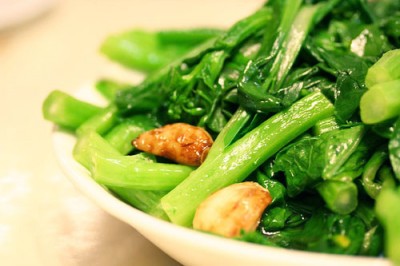Story & Photos Christina Ng.
With the exception of bok choy, most people are not all that familiar with Asian greens. But with springtime just around the corner and perhaps the novelty of salad waning, maybe it’s worth looking into. Asian greens are chock full of vitamins and contain a wide variety of textures. Unlike their western-salad cousins, Asian greens are rarely eaten raw and can be quite filling as a dish. The best thing is that most of these greens can be prepared in minutes and can satisfy whatever flavor mood you’re in.
SAVORY: YU CHOY
Yu choy or choy sum is a favorite in Chinese households. Both its mild flavor and firm, yet tender texture make it an extremely versatile green. Depending on how old the yu choy is, the stalks can become mildly bitter and usually require a slight trimming before cooking. It’s usually sauteÌed with oil and garlic and topped off with a dollop of oyster sauce, which really brings out the yu choy’s sweetness. Yu choy is packed with iron and vitamins A and C, and has been referred to as a super green.
Yu Choy with Oyster Sauce
-Blanch yu choy in boiling water for 30 seconds to 1 minute, depending on how crunchy you want the greens.
-In a pan, heat oil with chopped garlic until fragrant.
-Toss in yu choy and turn off the heat.
-Top with 1-2 tablespoons of oyster sauce and serve.
SWEET: CHINESE WATERCRESS
Chinese watercress is very similar in flavor to western watercress. The juicy stalks and peppery leaves lend itself well to soups, which is how the Chinese love to prepare watercress. As the watercress cooks, the pepperiness mellows and the leaves become sweeter. Watercress is known to be an anti-cancer superfood and is high in vitamins A, B, C, and K and also in minerals like iron and calcium.
Sweet Watercress Soup
-Simmer 1â„2 pound of cubed pork, a small handful of goji berries, and a small handful of jujubes or dates with a quart of water for about 1 hour.
-Add in watercress and some cubed tofu and continue to simmer for an additional 20 minutes.
-Add salt to taste.
BITTER: BITTER MELON
Bitter melon is similar to a lumpy, bitter cucumber, so by no means does its appearance or taste seem appealing, but surprisingly, bitter melon is very widely eaten across Asia. It’s packed with vitamin C and is used regularly in herbal medicines for digestion and diabetes. It’s also good in pork dishes, and many people will cook the melon with sugar or a sauce to diffuse the bitterness. Do remember to scoop out the center of the melon, as the insides are quite tough.
Bitter Melon with Minced Pork
– In a pot of boiling water, cook two bitter melons that are cut into 1â„4-inch slices for 2-3 minutes.
– In a frying pan, brown 1â„4 pound of minced pork with a teaspoon of minced garlic, soy sauce, and rice wine. Add salt, pepper, and sugar to taste.
-Toss in bitter melon and sauteÌ for 30 seconds. Remove onto a plate.
– Deglaze pan with several tablespoons of water mixed with a little bit of cornstarch. Cook for 30 seconds until sauce thickens.
– Toss sauce with the meat and bitter melon. Serve warm.
The Chinese also call this water spinach, kong xin cai, which literally translates to “hollow vegetable”. Tong choy is known for its crunchy, straw-like stalks. In the past, the green has been known to grow in waterways and canals, giving it the reputation of an unclean or unhealthy green. However, today tong choy is grown in farms across the U.S. and is a good source of vitamins A and C, folate, and other minerals like magnesium and iron. Tong choy is traditionally eaten with fermented tofu, which is slightly fishy, spicy, and creamy, and can be found in your local Asian grocery store. Some quick tips when cooking tong choy is to wash the stalks thoroughly as it does get very sandy. Also when cooking, try to put in the stalks first because it takes a little longer to cook than the more delicate leaves on top.
Tong Choy with Fermented Tofu
– Wash stalks thoroughly and cut stalks in half so that the bottom stalks are separated from the top leaves.
– In a pot of boiling water, cook stalks for about 3 minutes. Then put in leaves and cook for an additional 1-2 minutes.
– Drain and add several cubes of fermented tofu into the greens. Mix until cubes are creamy and well combined.
SOUR: SUAN CAI
Sometimes referred to as the Chinese sauerkraut, suan cai is a lacto-fermented, mustard green. Lacto-fermentation is different from pickling in that it doesn’t use vinegar, but instead uses the vegetable’s natural bacteria to ferment itself (like kimchi and sauerkraut). There are numerous health benefits associated with lacto-fermented foods, as it introduces good bacteria back into your body. The Chinese use it as a condiment, mixed with pork dishes or sprinkled on top of noodles. A word of caution: Although suan cai translates into “sour vegetable,” it is also very salty, so feel free to rinse the fermented greens prior to serving.













